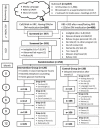The Effect of a Community-Based Self-Help Intervention: Korean Americans With Type 2 Diabetes
- PMID: 26184986
- PMCID: PMC4615366
- DOI: 10.1016/j.amepre.2015.04.033
The Effect of a Community-Based Self-Help Intervention: Korean Americans With Type 2 Diabetes
Abstract
Introduction: Korean Americans are one of the most underserved ethnic/linguistic minority groups owing to cultural and institutional barriers; there is an urgent need for culturally competent diabetes management programs in the Korean American community for those with type 2 diabetes. The purpose of this study was to test the effectiveness of a community-based, culturally tailored, multimodal behavioral intervention program in an ethnic/linguistic minority group with type 2 diabetes.
Design: An RCT with waitlist comparison based on the Predisposing, Reinforcing, and Enabling Constructs in Education/environmental Diagnosis and Evaluation (PRECEDE)-Policy, Regulatory, and Organizational Constructs in Educational and Environmental Development (PROCEED) and self-help models. Data were collected between September 2010 and June 2013 and were analyzed in August-December 2014. Statistical significance was set at p<0.05.
Setting/participants: In a naturally occurring community setting, a total of 250 Korean Americans with type 2 diabetes were randomized into an intervention group (n=120) or a control group (n=130).
Intervention: The intervention consisted of key self-management skill-building activities through 12 hours of group education sessions, followed by integrated counseling and behavioral coaching by a team of RNs and community health workers.
Main outcome measures: Primary (clinical) outcomes were hemoglobin A1c, glucose, total cholesterol, and low-density lipoprotein at baseline and at 3, 6, 9, and 12 months. Secondary (psychosocial and behavioral) outcomes included diabetes-related quality of life, self-efficacy, adherence to diabetes management regimen, and health literacy.
Results: During the 12-month project, the intervention group demonstrated 1.0%-1.3% (10.9-14.2 mmol/mol) reductions in hemoglobin A1c, whereas the control group achieved reductions of 0.5%-0.7% (5.5-7.7 mmol/mol). The differences between the two groups were statistically significant. The intervention group showed statistically significant improvement in diabetes-related self-efficacy and quality of life when compared with the control group.
Conclusions: RN/community health worker teams equipped with culturally tailored training can be effective in helping an ethnic/linguistic minority group manage diabetes in the community.
Trial registration: ClinicalTrials.gov NCT01264796.
Copyright © 2015 American Journal of Preventive Medicine. Published by Elsevier Inc. All rights reserved.
Figures
References
-
- Fonseca VA, Kirkman MS, Darsow T, Ratner RE. The American Diabetes Association diabetes research perspective. Diabetes Care. 2012;35(6):1380–1387. http://dx.doi.org/10.2337/dc12-9001. - DOI - PMC - PubMed
-
- Whiting DR, Guariguata L, Weil C, Shaw J. IDF diabetes atlas: global estimates of the prevalence of diabetes for 2011 and 2030. Diabetes Res Clin Pract. 2011;94(3):311–321. http://dx.doi.org/10.1016/j.diabres.2011.10.029. - DOI - PubMed
-
- Chow EA, Foster H, Gonzalez V, McIver L. The disparate impact of diabetes on racial/ethnic minority populations. Clinical Diabetes. 2012;30(3):130–133. http://dx.doi.org/10.2337/diaclin.30.3.130. - DOI
-
- Peek ME, Ferguson M, Bergeron N, Maltby D, Chin MH. Integrated community-healthcare diabetes interventions to reduce disparities. Curr Diabetes Rep. 2014;14(3):467–474. http://dx.doi.org/10.1007/s11892-013-0467-8. - DOI - PMC - PubMed
-
- Pistulka GM, Winch PJ, Park HJ, Han HR, Kim MT. Maintaining an outward image: a Korean immigrant’s life with type 2 diabetes mellitus and hypertension. Qual Health Res. 2012;22(6):825–834. http://dx.doi.org/10.1177/1049732312438778. - DOI - PubMed
Publication types
MeSH terms
Substances
Associated data
Grants and funding
LinkOut - more resources
Full Text Sources
Other Literature Sources
Medical



